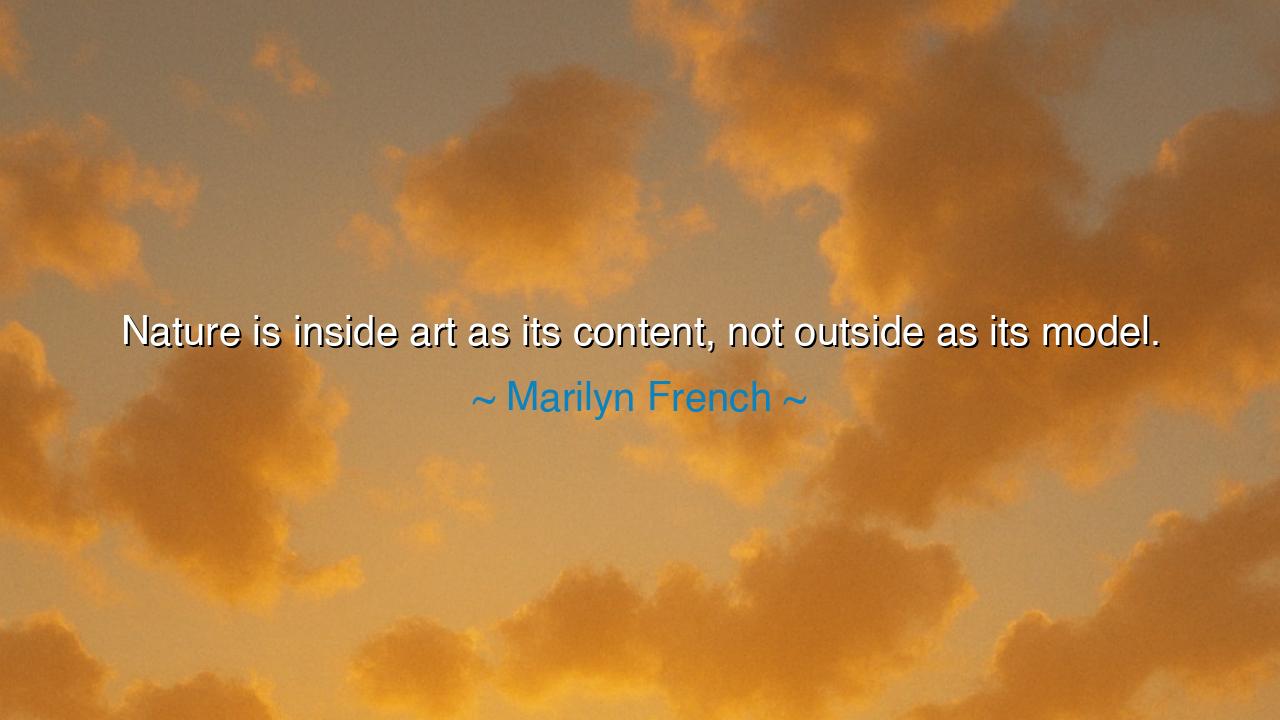
Nature is inside art as its content, not outside as its model.






Marilyn French once declared: “Nature is inside art as its content, not outside as its model.” These words strike like a bell across the ages, calling us to see with deeper eyes. Too often men and women have thought of art as a mere reflection, a mirror held up to the mountains, the rivers, and the skies. But French reveals a higher truth: that nature does not merely stand outside the painter’s canvas or the poet’s verse—it flows within them as lifeblood, as essence, as soul. Art is not an imitation of the outer world, but the embodiment of the inner one, where nature dwells as content, shaping thought and feeling from within.
The origin of this wisdom lies in French’s profound understanding of literature and the human spirit. As a writer, she knew that the grandeur of a forest or the rhythm of the sea could not be captured by copying their shapes alone. True art arises when the artist allows nature to seep into the heart, to become memory, passion, and meaning. What is then created is not a cold duplicate, but a living work—infused with the essence of wind, the weight of stone, the fragrance of earth. Thus, nature in art is not model but content, not shadow but flame.
The ancients themselves grasped this mystery. The poets of old did not merely describe rivers; they saw in rivers the symbol of life’s flow. They did not only paint the sun; they worshiped in it the eternal fire of existence. The Greek sculptors carved marble not to replicate the body, but to reveal the inner harmony that nature had whispered into their souls. When Homer sang of the wine-dark sea, he was not copying its hue, but revealing the awe and dread it stirred in the heart of man. So too does French remind us that art is born when nature’s content moves within us and becomes spirit made visible.
Consider the story of Vincent van Gogh. His fields of wheat, his swirling night skies, were not photographs of what stood before him. The stalks bent not only with the wind, but with the weight of his yearning and sorrow. The stars did not shine as mere orbs of gas; they burned with the fire of his restless soul. To some, his art seemed chaotic, unreal. Yet in truth, he captured nature more deeply than any realist could—for in his work, nature lived as content, alive within him, and made eternal upon canvas. His paintings remind us that true art is not about copying what the eyes see, but revealing what the soul perceives.
Thus, the meaning of French’s words becomes clear: art is not outside looking upon nature, but inside, carrying nature’s essence within itself. Every work of art that endures does so because it holds more than surface—it holds roots, storms, blossoms, and silences, carried into human expression. The tree painted on a canvas is not merely bark and leaves—it is longing, endurance, shelter, and the memory of countless springs. The poet’s sea is not mere salt water—it is freedom, terror, and eternity.
The lesson for us is powerful: when we create, let us not imitate, but embody. Whether in painting, writing, building, or living, let us take nature into ourselves, let it become content, and then let us bring it forth in new forms. Do not be satisfied with outward likeness, for that fades quickly. Instead, seek the inner essence, and let your work reveal what lies beyond the surface. In this way, every act of creation becomes an offering that honors both art and nature, fused as one.
In your own life, practice this wisdom. Do not merely look at the tree—feel its endurance in your own heart. Do not only admire the mountain—carry its steadfastness in your actions. When you speak, when you write, when you work, let the content of nature shape your words and deeds. Make of your life itself a work of art that reveals the rivers and skies within you.
Therefore, remember Marilyn French’s truth: “Nature is inside art as its content, not outside as its model.” For in embracing this, we no longer live as imitators of the world, but as creators who carry the world within. And when we bring forth that inner content, our works—whether humble or grand—become not copies of life, but life itself, reborn through the fire of the human spirit.






AAdministratorAdministrator
Welcome, honored guests. Please leave a comment, we will respond soon